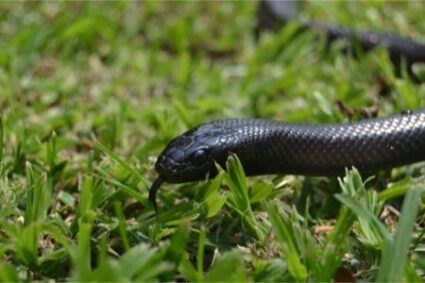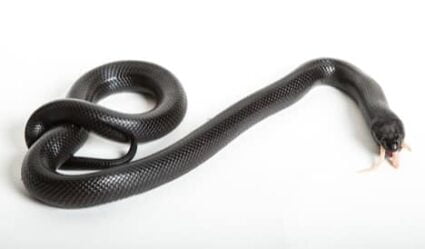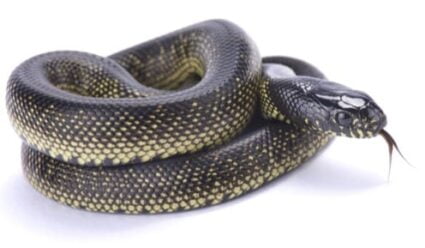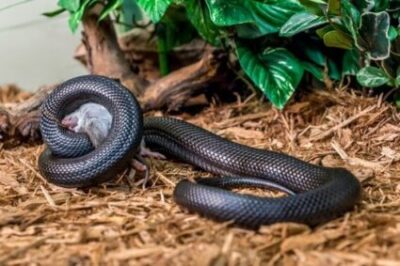Mexican black kingsnakes (Lampropeltis getula nigrita) are a deep and shiny black color, with hints of chocolate. As juveniles, they may have small yellow spots on some of their scales. They may also have white dots under their chin. They are slender and grow to an average of 3 to 5 feet in length.
An adult snake requires a 20-gallon enclosure. There should be a hot side (85-90 degrees) and a cool side (75-80 degrees) to regulate their metabolism. Your snake should be fed a medium-sized rodent every 10-14 days. They aren’t aggressive and have a good handling temperament.
They are non-venomous colubrids, and a subspecies of the common kingsnake. They’re ideal pets for beginners, and have become the most popular kingsnake in recent years. The average price of a Mexican black kingsnake is between $100 and $200. You should always buy from reputable dealers.
How to Care for a Mexican Black Kingsnake
The primary consideration when caring for any snake is its enclosure. If you set up its enclosure incorrectly, your snake is likely to experience health problems. These stem from you not replicating its natural environment sufficiently for it to thrive in captivity.
You have to get everything right, from the size of the enclosure and the material it’s made from, to the substrate you use, the humidity and temperature levels, and lighting.
Mexican Black Kingsnake Care Sheet
| Healthy Length and Width | 3-5 feet |
| Healthy Weight | 3-4lbs |
| Ambient Temperature | 75-80 degrees |
| Basking Temperature | 88-90 degrees |
| Humidity Range | 40-60% |
| Cage Substrate Material (Bedding) | Aspen shavings |
| Cage Lighting Required? | No, if they have natural light |
| Juvenile Feeding Frequency | 2-4 times per week |
| Juvenile Portion Size | 1 pinky or fuzzy, depending on snake size |
| Adult Feeding Frequency | 10-14 days |
| Adult Portion Size | Enough to leave a small lump in their stomach |
Tank Size and Setup
A snake’s enclosure has to be the optimal size for its needs. If it’s too small, it will be cramped, restless, and bored. If it’s too big, it will feel intimidated by the open space and become stressed.
The snake shouldn’t be any more than twice as long as its enclosure. Any smaller and they would be too cramped to move freely. You’ll likely need several enclosures.
The first is for when the snake is a juvenile (10 gallons), and the second is for when they are an adult (20 gallons). You ‘may’ also want to get a third for hatchlings.
If you get your kingsnake as a tiny hatchling, consider keeping them in a plastic tub (with breathing holes.) These are small, but ideal if you have several snakes and not much room. Breeders use small tubs to house hatchlings before they’re sold. A small Tupperware tub is just fine.
An adult’s tank should contain some enrichment and entertainment so your snake doesn’t get bored. Kingsnakes aren’t arboreal snakes, but you can still have a branch and some foliage to provide them with cover. You should also provide two hides to keep stress levels to a minimum.
Enclosure Temperature
Because they originate from a desert environment, Mexican black kingsnakes require their cage to be warm. It should be a lot warmer than room temperature. If you don’t heat its cage correctly, your snake will become too cold and experience health and digestive issues:
- Too low temperature. It can’t digest food, so it’ll regurgitate food before it can digest it.
- Too high temperature. Bacteria will flourish. This causes mouth rot and scale rot. If the temperature gets even higher, it can also cause neurological issues.
All pet snakes require a cage that has a cool side and a warm side. This is because snakes are cold-blooded, i.e., they don’t produce their own body heat. They have to regulate their temperature by moving to warmer or cooler parts of their environment.
The ambient temperature in the enclosure should be between 75-80 degrees. Their basking spot should reach 88-90 degrees. All of the heating and lighting should be on the warmer side of their enclosure. At night, you can allow the ambient temperature to drop to 72 degrees.
Heating Methods
The most common heating method is the heat pad. This sits underneath one half of the cage. They usually have a gauge that allows you to control the temperature manually.
Heat tape is similar to a heat mat. But instead of being one pad, it’s a long roll of non-stick plastic. Breeders use heat tape in stack setups to provide warmth to multiple snakes in different enclosures.
You could also use a ceramic heat bulb. These warm up like a regular light bulb, but don’t emit light. They only give off heat. Or, you could use a regular light bulb, because these give off heat too. These double as a form of lighting, which can be useful.
You also have to provide places (hides) that the snake can cool down. Hides provide a space that the snake can escape into the shade, like they do in the wild. If you want one hide, put it on the cool side of the enclosure. You could also have two, putting one on each side.
Hides double as a way of helping your snake shed, because you can put a damp paper towel inside for the snake to sit on. This is a ‘moist hide,’ and helps the snake loosen their skin before shedding.
Humidity Level
Maintaining humidity is vital for your snake’s health. If it’s too low, the snake will have trouble shedding. Instead of its skin coming off in one go, it will come off in chunks. This can cause stress, or even sepsis if the skin on their tail cuts off its circulation.
High humidity will also cause problems. If it’s too high, your snake will experience respiratory infections because of excess bacteria. Humidity encourages bacteria to thrive in the substrate. And if the substrate is wet, it will cause scale rot on the snake’s underside. This can kill them.
A kingsnake needs a humidity level of between 40 and 60%. It’s advisable to keep it in the middle of that range, at around 50%. When the snake enters the blue phase, and until they shed, you can increase this to 60% to help get rid of their old skin.
You’ll need a hygrometer (humidity meter) to check the humidity level in their enclosure. These are effective, and perform such a crucial role that you can’t go without one. There are several ways of upping the humidity in a snake’s enclosure. The most common are as follows:
- Spray bottle. When you notice the humidity is too low, give the cage a quick spray.
- Automatic misting system. Like spray bottles, but they work automatically.
- Bowl of water in the enclosure. Bodies of water evaporate slowly, which increases humidity.
- A room that’s already humid. If a room is humid, perhaps because of a washing machine and dryer, this may be a good place to keep your snake’s cage/enclosure/tank.
A bowl of water is an especially good addition to a kingsnake’s enclosure. Your snake will sit in the bowl for fifteen minutes before it sheds. There’s no need to monitor your snake. Change the water in their bowl daily, and scrub the bowl weekly to prevent the build-up of bacteria.
Bedding and Substrate
The type of substrate depends on the snake’s natural habitat. A Mexican black kingsnake lives in a rocky, desert environment. It should, therefore, be housed in a dry substrate. Aspen shavings, cypress mulch, and paper are good options. Change damp substrate regularly.
You should use enough substrate that your snake can burrow. Mexican black kingsnakes regulate their temperature by alternating between burrowing and basking. One or two inches is optimal.
Lighting
Snakes don’t usually need lighting. Keep them in a room with a window so that they have access to natural light. However, there are certain situations where it would be beneficial to provide lighting:
- Wooden enclosure. These typically have three wooden sides, so don’t allow much light in.
- No windows. If your snake’s enclosure is in a room with no windows.
- Minimal daylight. If you live in a part of the world that has a low amount of daylight. This only applies in the far north or far south of the world.
When a snake doesn’t have access to sunlight, it affects its health. Snakes can tell the movement of the seasons based on sunlight and warmth. You keep them at the same temperature throughout the year, so sunlight becomes the only way that they can determine the season.
Without being able to tell the season, this has knock-on effects on breeding, feeding, and more. A basking lamp provides warmth and light. Failing that, a basic light bulb is fine. Ensure it can’t touch it by placing a mesh cage around the bulb, or keeping the bulb on the outside of the tank.

Cleaning the Enclosure
Spot cleaning involves checking to see if your snake went to the toilet or spilled its water. If it did, get rid of the soiled part of the substrate.
At least once a month, disinfect the enclosure thoroughly. Take the snake out and keep it in a tub while you sanitize it. Follow the instructions with your cleaning solution. Clean everything that can be safely sprayed, and put in fresh substrate afterwards.
Feeding Schedule
Almost all snakes are carnivores. They eat nothing but meat, although the kind of meat varies depending on species. The only exception is egg-eating snakes.
In the wild, Mexican black kingsnakes eat a varied diet. They will feed on any animal that’s small enough for them to overpower, like rodents, amphibians, small birds, and other snakes. However, despite naturally eating a diverse diet, they can survive by just eating rodents.
Meal Plan
| Age | Portion Size | Frequency |
|---|---|---|
| Just hatched | No food | No food |
| 7-10 days | 1 pinky | Once |
| First 2 months | 1 pinky | 2 to 4 times per week |
| 2-4 months | 1 fuzzy | 2 to 4 times per week |
| 4 months to 1 year | 1-2 fuzzies | 2 times per week |
| 1 year+ | Large mice, i.e. adults | 10-14 days |
What to Feed a Juvenile
A juvenile Mexican black kingsnake can start eating rodents from its first feed. Its first feed should be a week or ten days after it hatches. If it doesn’t bite at first, try the next day.
The easiest way to feed any snake is by purchasing frozen rodents in bulk. A rodent contains every nutrient that a kingsnake needs. These rodents come in several sizes.
The smallest, and therefore the most appropriate for juveniles, is the pinky. Pinkies are tiny mice pups that are killed and frozen at about a day old. Feeding the snake once every 5 – 7 days is fine. The portion size is one pinky.
The first year of development is when it grows more than any other point. As the snake grows, you should increase its portion size. The next size up of rodent is fuzzy. As the snake grows larger, you can either feed it 2 pinkies or 1 fuzzy/adult mouse.
What to Feed an Adult
An adult kingsnake should eat a larger portion, but on a more infrequent basis. It should eat 2 mice once every 10-14 days. The portion should be enough to leave a small lump in its stomach.
However, each snake is different. Some snakes will eat more or less frequently than others. A good rule of thumb is to watch for when the snake defecates.
Defecation is a sign that it’s ready to feed again. Try feeding it two days after it goes to the toilet, and it will almost always accept the meal.

Healthy Size and Weight
The average length of a Mexican black kingsnake is between three and five feet. A healthy snake will weigh between three and four pounds. If you’re unsure whether your snake is a healthy size and weight, then you can assess it using the following scale:
- Snake is underweight. Its spine will show up along its back, and its sides will be slightly caved in. Its cross-section will look like a triangle.
- Snake is overweight. Its spine won’t show. Its sides will bulge out so that the cross-section looks like a circle. Their neck will become chubby, and its middle will become much fatter.
- Snake is an optimal weight. Its underside will be flat against the ground, but its top will be curved. Its middle will be a little wider than its neck, but not by much.
Handling Information
Start by getting your snake used to you. Stand next to its enclosure without making any sudden movements. Reach your hand inside the enclosure and gauge its reaction.
If it gets defensive, withdraw your hand. If it flicks its tongue towards you, it’s sniffing you and checking whether you’re a threat.
- If it’s comfortable with you, pick it up and move it out of the enclosure.
- If it isn’t comfortable, try again tomorrow. If it still isn’t happy, take it out of the enclosure with a snake hook instead.
Hold it gently but securely. It won’t feel slimy or sticky, because snakes are smooth and muscular. The snake will try slithering up your arm or away from you. This isn’t a sign that it doesn’t like you. It is trying to explore. Let it move freely without allowing it to drop.
The handling time for a Mexican black kingsnake is between 15 minutes and 2 hours. Your snake will let you know by getting visibly frustrated and trying to get away from you.
Do’s and Don’ts of Handling
You should support a kingsnake under its body when you handle it. They aren’t an arboreal snake, which means that they don’t sit or live in trees.
Snakes that do are better at climbing along arms, hands, and fingers. You should support them by holding them at 1/3 and 2/3rds of the way along their bodies. They don’t like any sudden movement, especially through the air. They don’t like being squeezed. Here’s a quick guide:
- Don’t handle it when it’s expecting to be fed. It will associate your hands with food.
- Don’t reach in and pull it out from its enclosure if it’s scared. Instead, use tongs. Over time, it will become comfortable, and you can take it directly from its enclosure.
- Handle it twice a week. More than this and it will become overly stressed. Less than this and it won’t get used to you.
- Spend time with your snake that isn’t just handling or feeding.
Are They Aggressive?
Captive-bred pet snakes are not aggressive because they’re used to people. However, any snake can become ‘cage aggressive.’ This is where the snake gets defensive and lashes out when you try to lift it from its enclosure. This makes handling impossible unless you lift it out with a hook.
Cage aggression usually occurs when you don’t spend time with your snake, aside from feeding it. You can prevent this by getting it used to you through regular, non-stressful handling.
Venomous vs. Non-Venomous
Mexican black kingsnakes are constrictors: they wrap around their prey to kill it, rather than use venom. Venomous and non-venomous snakes are biologically different.
A venomous snake has features that a non-venomous snake doesn’t. The most obvious is its fangs. These are long and hollow, and can shoot out poison/venom.
They also have venom glands. These are at the back of the head, near the neck. They store small amounts of venom. When the snake contracts the muscles around these glands, the venom squeezes into two ducts that connect to their two fangs. It then shoots out.
Some snakes have slightly venomous spit. But kingsnakes don’t have that either. Not having venom means they are nowhere near as dangerous as other snake species.
Bite Information
If you don’t handle them correctly, a Mexican kingsnake could bite you. All snakes bite.
They do so because it’s their only form of self-defense. But constrictors are far less likely to defend themselves by biting, so kingsnakes will only bite if you mishandle them.
Caring for Bites
If you’ve been bitten, hold the snake where their neck and head meet. Push downwards, towards the bite site. This will cause its teeth to disengage. You can then put it back into its enclosure.
Rinse and clean the bite mark with a mild disinfectant. Apply a bandage to prevent infection. If an infection does occur, repeat the washing process, and start a course of antibiotics.
Breeding Information
You’ll need small tubs as enclosures, substrate, and food. You’ll also need heat tape and a way of stacking/storing the tubs.
Unrelated snakes are recommended, but breeding related snakes (line breeding) is usually okay, if you’re not using morphs. Snakes morphs can have other mutated genes, which can cause health problems when inbreeding.
Get confirmation that they’re males and females. You can do this by having the snake sexed. If you don’t know how, ask the breeder to do it for you. It involves checking whether the male has hemipenes by ‘popping’ them.
Don’t use wild-caught snakes, only captive-bred ones. Check them for mites, ticks, and infectious conditions before breeding. Ideally, you should have more than one male and female. Groups of two males to four females are recommended.
It’s also advisable that you get juvenile snakes, and grow them, rather than getting adults. Adults for sale aren’t always fertile, even if they’re advertised as such. Breeders don’t tend to sell successful breeders because more money can be made through their offspring.
If you do get juveniles, wait until they’re physically ready to breed. Wait until they’re at least three and a half feet, and 300g minimum for females. They will reach this size and weight after three years.

Temperature Cycling
Temperature cycling is where you first cool the snake’s environment before warming it up again. This simulates winter and spring. Spring is when snakes breed in the wild, so cycling gets them ready.
You should cycle them at the end of October. Wait until your snake goes to the toilet. Then, lower the temperature to sixty degrees. Do so gradually over a week.
At the beginning of March, raise the temperature again, slowly. Keep the temperature of its basking spot at 85 degrees max until the summer.
During this time, the snakes won’t want to feed. That’s natural. They can’t digest in cooler temperatures. This won’t hurt them, because it’s what they do in the wild.
Introducing the Snakes
Once they’ve been temperature-cycled, you should feed the snakes. Offer them as much food as they want because they’ll be hungry. They may also shed at this time. Offer them food even if they’re shedding (although they may not want it).
Start by putting the females all in one enclosure. Only place snakes of the same size together. If one snake is substantially smaller, there’s a chance that a larger one will eat her. Then, introduce the male for a few hours. Watch to see if they breed. You’ll notice breeding activity easily:
- The male will start by sniffing the female’s body. He does this by flicking his tongue.
- He will then try and slide on top of the female’s back.
- From here, he will wrap his tail around hers. His hemipenes will evert, meaning they’ll pop out naturally. He will then try and lift the female’s tail to find her cloaca.
At this point, he will try for a ‘cloacal kiss’. That means he will try to put his hemipene inside the female’s cloaca, which is how snakes have sex. This will take around ten minutes, but can take hours, depending on the snake. He will leave behind a cloacal plug, which stops other males from breeding.
If they don’t breed at first, don’t worry. They often don’t. After a few hours, take him out of the enclosure. Reintroduce him again two or three days later. For maximum effect, continue until all the females have bred with the male/males.
Egg Laying Box
The female will then hold onto the male’s sperm. She may use it straight away to fertilize her eggs, but can wait for a year or more.
Two months after successfully mating, the female will shed. Her eggs will start growing inside her at this point. They will make her back end swell up. When you notice this, provide her with a special box to lay her eggs in. This box should:
- Be more humid than usual. Eggs require high levels of humidity. It also helps the laying process.
- Contain a substrate that holds onto moisture well, e.g. sphagnum moss.
- Be small and secure enough that the female feels safe inside.
Wait until the female sheds before putting her into the box. She will then lay her eggs around a week afterwards. A Mexican black kingsnake’s average clutch size is around nine eggs, but it’s not a bad sign if they don’t produce that many.
Create your egg box from a Tupperware tub. Fill it with a layer of vermiculite and give the substrate a spray. Make small indentations for each egg, with your thumb, so that they don’t roll around.
Carefully mark the eggs. Place a dot at the top of the egg, the part that’s facing upwards. Pick them up without damaging them, and place them in the egg box, with the dot still facing up.
Incubation of Eggs
Set up your incubator. Allow it to reach the appropriate temperature before putting the eggs inside. Place the egg box inside, and spray them whenever necessary. Leave the lid slightly off to encourage ventilation, or have a couple of air holes in the lid.
The humidity should be near 100% at all times. The temperature should be between 80 and 82 degrees, and shouldn’t vary. Don’t unplug the incubator or change the temperature at any point. You might want to hook it up to a generator just in case. The eggs will start hatching after 55 to 75 days.
Caring for Baby Snakes
If you want to run a breeding program, you should have a stack. These can contain lots of small boxes stacked on top of each other. Small plastic Tupperware tubs are fine. Line them with a cheap but suitable substrate like Aspen shavings.
Use heat tape to maintain temperature, and spray regularly to maintain humidity. Attach a piece of paper to the top of each tub. On this piece of paper, write a record of everything about the snake, i.e. male/female, when it hatched, and whether it’s eating yet.
Don’t be worried about overfeeding. This is a crucial period in a snake’s development, during which it’ll grow more than any other time. You can feed it 3-4 times a week with no adverse effects.

